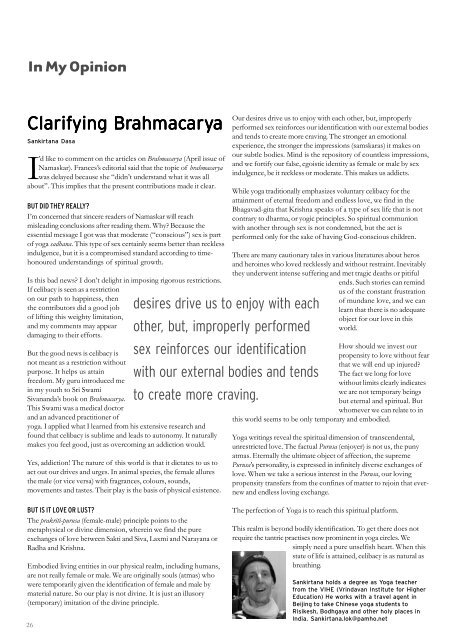Create successful ePaper yourself
Turn your PDF publications into a flip-book with our unique Google optimized e-Paper software.
In My Opinion<br />
Clarifying Brahmac<br />
ahmacary<br />
arya<br />
Sankirtana Dasa<br />
I’d like to comment on the articles on Brahmacarya (April issue of<br />
<strong>Namaskar</strong>). Frances’s editorial said that the topic of brahmacarya<br />
was delayed because she “didn’t understand what it was all<br />
about”. This implies that the present contributions made it clear.<br />
BUT DID THEY REALLY?<br />
I’m concerned that sincere readers of <strong>Namaskar</strong> will reach<br />
misleading conclusions after reading them. Why? Because the<br />
essential message I got was that moderate (“conscious”) sex is part<br />
of yoga sadhana. This type of sex certainly seems better than reckless<br />
indulgence, but it is a compromised standard according to timehonoured<br />
understandings of spiritual growth.<br />
Is this bad news? I don’t delight in imposing rigorous restrictions.<br />
If celibacy is seen as a restriction<br />
on our path to happiness, then<br />
the contributors did a good job<br />
of lifting this weighty limitation,<br />
and my comments may appear<br />
damaging to their efforts.<br />
But the good news is celibacy is<br />
not meant as a restriction without<br />
purpose. It helps us attain<br />
freedom. My guru introduced me<br />
in my youth to Sri Swami<br />
Sivananda’s book on Brahmacarya.<br />
This Swami was a medical doctor<br />
and an advanced practitioner of<br />
yoga. I applied what I learned from his extensive research and<br />
found that celibacy is sublime and leads to autonomy. It naturally<br />
makes you feel good, just as overcoming an addiction would.<br />
Yes, addiction! The nature of this world is that it dictates to us to<br />
act out our drives and urges. In animal species, the female allures<br />
the male (or vice versa) with fragrances, colours, sounds,<br />
movements and tastes. Their play is the basis of physical existence.<br />
desires drive us to enjoy with each<br />
other, but, improperly performed<br />
sex reinforces our identification<br />
with our external bodies and tends<br />
to create more craving.<br />
Our desires drive us to enjoy with each other, but, improperly<br />
performed sex reinforces our identification with our external bodies<br />
and tends to create more craving. The stronger an emotional<br />
experience, the stronger the impressions (samskaras) it makes on<br />
our subtle bodies. Mind is the repository of countless impressions,<br />
and we fortify our false, egoistic identity as female or male by sex<br />
indulgence, be it reckless or moderate. This makes us addicts.<br />
While yoga traditionally emphasizes voluntary celibacy for the<br />
attainment of eternal freedom and endless love, we find in the<br />
Bhagavad-gita that Krishna speaks of a type of sex life that is not<br />
contrary to dharma, or yogic principles. So spiritual communion<br />
with another through sex is not condemned, but the act is<br />
performed only for the sake of having God-conscious children.<br />
There are many cautionary tales in various literatures about heros<br />
and heroines who loved recklessly and without restraint. Inevitably<br />
they underwent intense suffering and met tragic deaths or pitiful<br />
ends. Such stories can remind<br />
us of the constant frustration<br />
of mundane love, and we can<br />
learn that there is no adequate<br />
object for our love in this<br />
world.<br />
How should we invest our<br />
propensity to love without fear<br />
that we will end up injured?<br />
The fact we long for love<br />
without limits clearly indicates<br />
we are not temporary beings<br />
but eternal and spiritual. But<br />
whomever we can relate to in<br />
this world seems to be only temporary and embodied.<br />
Yoga writings reveal the spiritual dimension of transcendental,<br />
unrestricted love. The factual Purusa (enjoyer) is not us, the puny<br />
atmas. Eternally the ultimate object of affection, the supreme<br />
Purusa’s personality, is expressed in infinitely diverse exchanges of<br />
love. When we take a serious interest in the Purusa, our loving<br />
propensity transfers from the confines of matter to rejoin that evernew<br />
and endless loving exchange.<br />
BUT IS IT LOVE OR LUST?<br />
The prakriti-purusa (female-male) principle points to the<br />
metaphysical or divine dimension, wherein we find the pure<br />
exchanges of love between Sakti and Siva, Laxmi and Narayana or<br />
Radha and Krishna.<br />
Embodied living entities in our physical realm, including humans,<br />
are not really female or male. We are originally souls (atmas) who<br />
were temporarily given the identification of female and male by<br />
material nature. So our play is not divine. It is just an illusory<br />
(temporary) imitation of the divine principle.<br />
26<br />
The perfection of Yoga is to reach this spiritual platform.<br />
This realm is beyond bodily identification. To get there does not<br />
require the tantric practises now prominent in yoga circles. We<br />
simply need a pure unselfish heart. When this<br />
state of life is attained, celibacy is as natural as<br />
breathing.<br />
Sankirtana holds a degree as Yoga teacher<br />
from the VIHE (Vrindavan Institute for Higher<br />
Education) He works with a travel agent in<br />
Beijing to take Chinese yoga students to<br />
Risikesh, Bodhgaya and other holy places in<br />
India. Sankirtana.lok@pamho.net

















